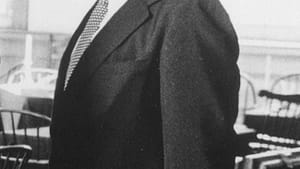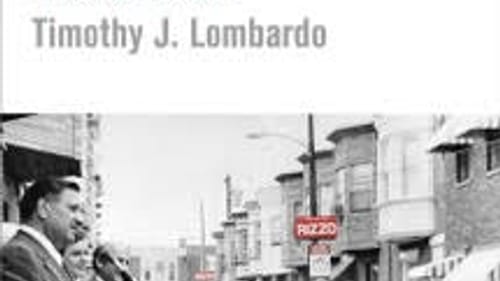Stay in the Loop
BSR publishes on a weekly schedule, with an email newsletter every Wednesday and Thursday morning. There’s no paywall, and subscribing is always free.
How we got here
‘Blue-Collar Conservatism: Frank Rizzo’s Philadelphia and Populist Politics’ by Timothy J. Lombardo

Past informs present in Blue-Collar Conservatism: Frank Rizzo’s Philadelphia and Populist Politics. Centering on the 1960s and ‘70s, author Timothy J. Lombardo concludes that Frank Rizzo’s career was fueled by the emergence of white working-class voters energized by pride, fear, anger, and often racism. An Italian-American son of South Philadelphia who became police commissioner and a two-term mayor, Rizzo understood their perspective, cultivated their trust, and became their hero.
Lombardo details the confluence of political and social currents to make the case that what happened a half-century ago in Philadelphia has much in common with what’s happening now across the nation.
A city of neighborhoods, for better and worse
Cities declined in the second half of the 20th century, losing jobs and population and experiencing rising poverty and crime. Philadelphia (then the nation’s fourth-largest city) was hard hit by deindustrialization, suburbanization, and demands for better housing and schools by citizens who, though increasingly diverse, lived in isolated, tight-knit neighborhoods.
Lombardo emphasizes Philadelphia’s “spatial segregation” — culturally homogenous neighborhoods that allowed tradition and bias to flourish. The physical alignment evolved through migration, urban redevelopment, and the post-World War II settlement of geographically remote, undeveloped Northeast Philadelphia, which was effectively a city-suburb hybrid. Like South Philadelphia, the Northeast was almost completely white. Both were Rizzo strongholds.
“Northeast Philadelphia neighborhoods were less likely to identify with a single ethnic group, but a white ethnicity remained a central feature,” Lombardo writes. Residents expressed their blue-collar pride with “a defensive and exclusionary position” and believed that “outsiders and newcomers would not take the same pride in their home and environment . . . especially when the proposed newcomers were from different racial backgrounds.”

Neighborhood insularity meant that many Philadelphians lived, worked, worshipped, and attended school with people just like themselves. Added to ongoing segregation in unions, professions, and community activities such as the Mummers parade, it led to polarization on issues like public housing, school integration, and law enforcement.
Revering the police
The struggle between liberalism and conservatism in the city also played out in the Philadelphia Police Department, where progressive law-enforcement proponents eventually lost out to the authoritarian approach Rizzo embodied.
As civil unrest grew, African Americans bore the brunt of crackdowns delivered by a police force that was still mostly white and male. Anger and resentment spiraled, leading to increasingly violent clashes.
Rizzo, a second-generation officer, reflexively defended cops on the street. Blue-collar conservatives who supported Rizzo as commissioner and mayor were strong police allies.
Lombardo describes a “culture of reverence” for police among white people that grew from admiration for the profession, which exemplified the toughness, pride, and hard work prized by blue-collar conservatives. Additionally, police were often friends and neighbors, because they were required to live in the city and gravitated to the Northeast’s space and newer housing. All that said, racism was also a significant factor in support for the police, for Rizzo and for where people stood on a range of civic issues.
“Color-blind”
Lombardo details flashpoints of the period, including proposed public housing at South Philadelphia’s Tasker Homes and the Northeast’s Morrell Park and the adoption of busing to achieve racially integrated schools. Objections, though, were expressed in terms of not race but class: “Many of those that claimed race did not matter to them genuinely were ‘color-blind,’” Lombardo writes. “For them, however, their color blindness was the ultimate luxury of their white privilege. They were the products of segregated environments that allowed them to mask their social privilege behind blue-collar identity politics and their veneer of color-blind values like toughness and hard work.”

When Rizzo became police commissioner in 1967, it marked the failure of an effort to make police more accountable, and the city became known for brutal enforcement. According to Lombardo, “Rizzo survived politically because his ‘one of us’ populism made him a hero to the white, ethnic, blue-collar Philadelphians that believed they were on the losing end of the equal opportunity politics of the 1960s.”
Déjà-vu, all over again
Which sounds all too familiar. Though the current president’s name isn’t mentioned until the last few pages, Lombardo’s thesis is that rising urban conservatism heralded a national shift to the right that reached its apex in 2016: “Ultimately, this is the story of how white, blue-collar Americans came to see their interests more aligned with conservatives than with liberals.”
Originally registered Republican, Rizzo became a Democrat when he was appointed police commissioner. He remained a Democrat through two terms as mayor, though his political alliances were fluid (for example, supporting Richard Nixon, a Republican). Rizzo reverted to Republicanism in 1987, when he challenged incumbent Wilson Goode for mayor, and in 1991, when he died while campaigning.
“His ultimate conversion from Democrat to Republican symbolized the culmination of blue-collar conservatism in the 1980s,” Lombardo concludes. “Blue-collar conservatives in the Democratic Party represented a new breed of Democrats that helped shift the party away from the welfare liberalism of the 1960s. They were Reagan Democrats in the 1980s and the blue-collar arm of Bill Clinton’s New Democrats in the 1990s. In Philadelphia and its surrounding suburbs, they started out as Rizzocrats.”
What, When, Where
Blue-Collar Conservatism: Frank Rizzo’s Philadelphia and Populist Politics. By Timothy J. Lombardo. Philadelphia: University of Pennsylvania Press, 2018. 328 pages, hardcover; $37.50. Click here.
Sign up for our newsletter
All of the week's new articles, all in one place. Sign up for the free weekly BSR newsletters, and don't miss a conversation.
